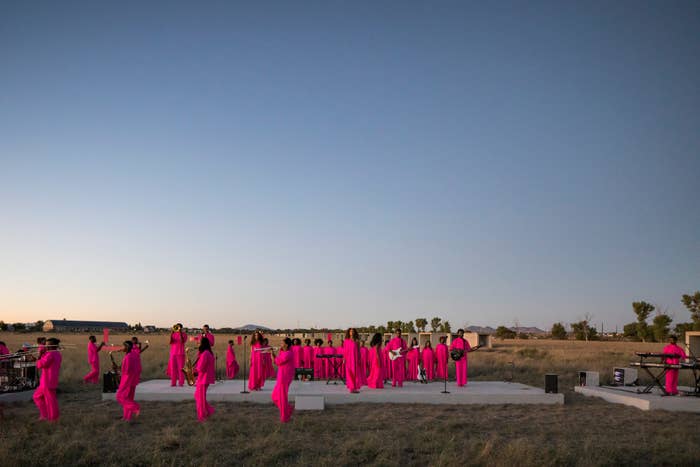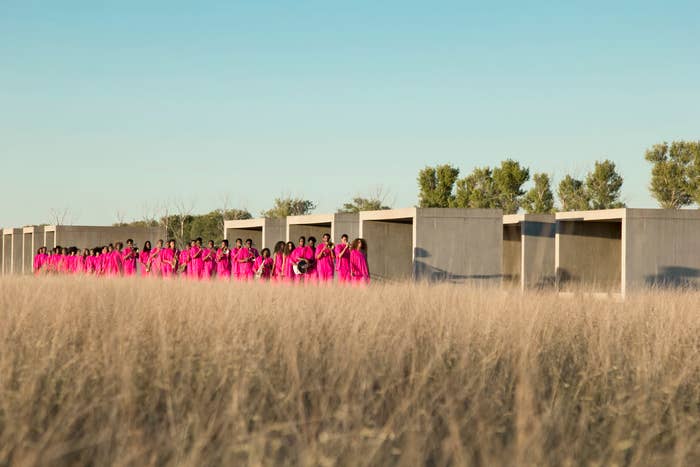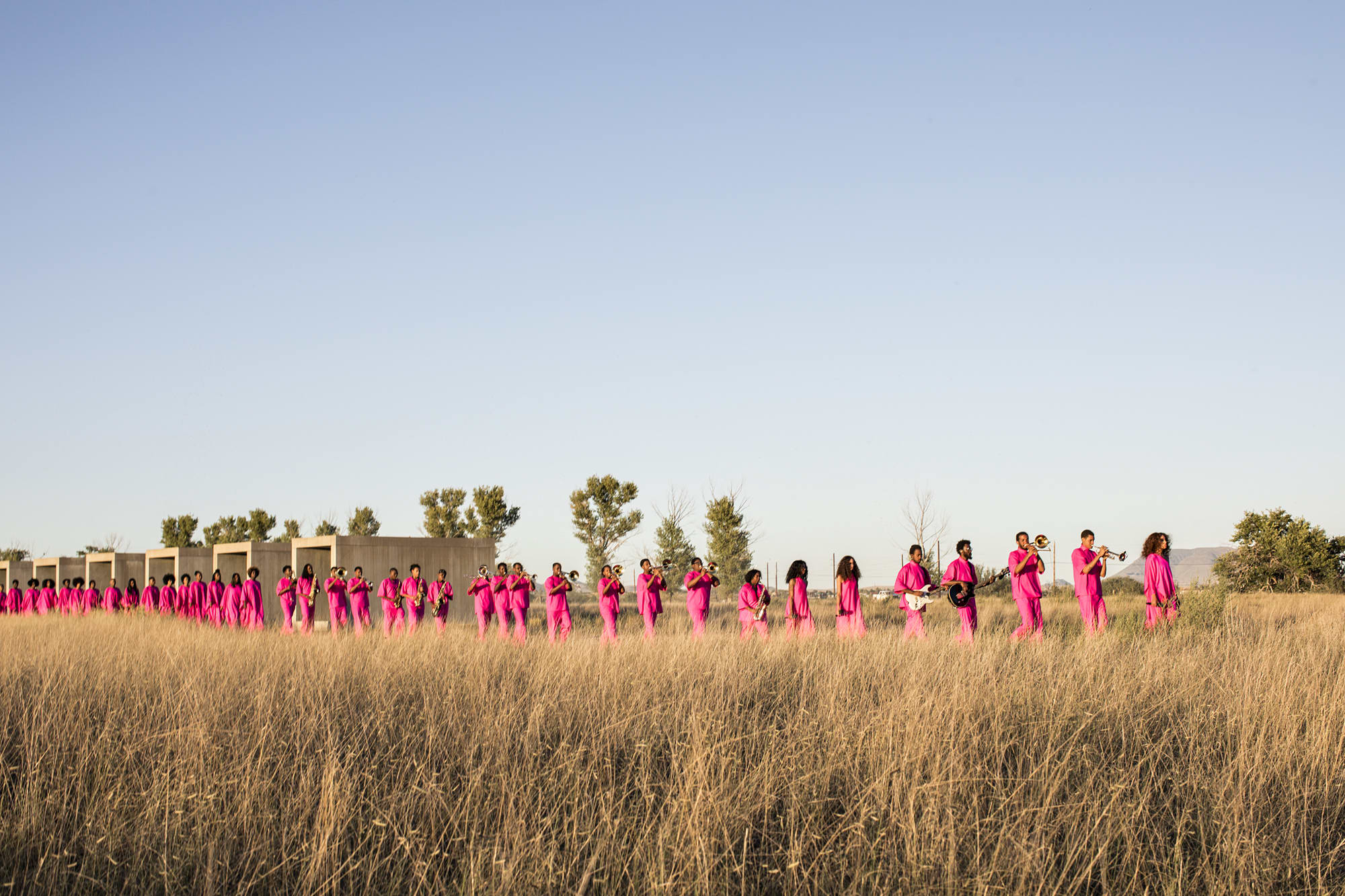
The drive from New Orleans to Marfa, Texas takes about 14 hours. From Houston, it’s closer to 9. From El Paso, Texas, near the New Mexico border, it’s about 3.
These cities and distances are significant. They are, according to various interviews, the places and road trips that inspired Solange Knowles during the creation of her 2016 album, A Seat At The Table. On Sunday, October 8, Knowles performed a piece titled “Scales” — songs from the album with new choreography and arrangements — on the site of an important Marfa museum, the Chinati Foundation, founded by the late artist, Donald Judd, in 1986. “Scales” provided a unique opportunity to witness Knowles as a boundless, multidisciplinary artist through a recontextualization of her music.
Knowles and her band of eight, young black men and women performed in front of Donald Judd’s massive Untitled concrete blocks, which sit throughout a brush expanse just larger than a football field. The blocks were installed there 33 years ago. At various points, the band was joined by a rotation of 32 more dancers and horn players. Knowles and these performers wore flowing, fuchsia garments, a color that gleamed next to the golden earth, trumpets, saxophones, and sunset. The 850 guests dressed in white, and arrived without cell phones, both by Knowles’ request.
These cues suggested that guests were meant to be active participants. To reach the stage, they walked a long, narrow trail in pairs, from Chinati’s entrance through these tall works of art, before finding a place to stand on the slope of a small hill. It took close to 45 minutes for all guests to simply walk this flat path and get to the stage, for a collective journey that was more contemplative than arduous. It caused one to think about belonging—this vast space and one’s place within it.

Then, a single-file line of fuchsia—18 people led by Solange—appeared at the same entrance and began to walk the same path slowly towards the audience, through Judd’s works, while a droning sound repeated in the background. 15 minutes later, they arrived. The droning stopped and became “Rise,” the first song from A Seat At the Table. The song’s harmonies echoed up the hill, encouraging and repeating a message of resilience:
“Fall in your ways, so you can crumble Fall in your ways, so you can sleep at night Fall in your ways, so you can wake up and rise”
Then came “Weary,” a song about skepticism and self-discovery: “Be leery about your place in the world / You're feeling like you're chasing the world.” It was as if the song was written for this massive desert expanse, the kind that’s as mind-opening as it is isolating. “And, ‘Do you belong?’ / I do,” it continues.
“Cranes In the Sky” came next, just as the sun began to set. It’s a song Knowles wrote comparing the ugliness and ignorance of the pre-recession real estate boom to the repercussions of avoiding difficult emotions. In Marfa, the song connected visually to its music video, one where Knowles engages with various architecture and similar landscapes.
During “Cranes,” the first 18 women from the cast were lined up 50 feet from the stage; their simple act of watching the performance provided a sense of community. At other times, half of them walked forward to join the stage, before walking back. Later, all of them joined the stage, with additional trumpet and saxophone players, to dance, stare, or make the subtle, geometric movements that Knowles choreographs. Again, a search for belonging, answered by space, building, and community, rooted this song, and those that followed, in Marfa’s solid earth.

“Mad,” “F.U.B.U.,” and “Don’t Touch My Hair” comprised the second half of “Scales” with social and political messages about black identity. Knowles engaged more directly with the audience, pointing when she sang “You have a right to be mad,” joining the crowd during “F.U.B.U.,” and gathering the entire group of performers for a passionate, celebratory rendition of “Don’t Touch My Hair,” before leading the entire group to run back through the trail to the start.
“Donald Judd’s work has has such profound influence on the way I view the world,” said Knowles on Instagram the day of the performance, nodding specifically to Judd’s beliefs related to “symmetry, space, shapes, and light.” She continued: “Judd’s philosophy that art takes on the space it exists in has resonated with me to the core, and his radical practice of building your OWN institutions is what has pulled me back to make the pilgrimage to Marfa for seven years.”
“Scales” certainly expanded Judd’s interpretations of these concepts, through symmetrical choreography, serialized movement, sonic repetition, the passing from day to night, and, of course, proximity to the precisely constructed and placed concrete blocks that embody these values so succinctly. Knowles also placed her own fuchsia rounds and rectangles in the field behind the stage, creating further dialogue with the legacy of Judd’s practice.

Over the past year, Knowles has performed A Seat At the Table at her own concerts, during music festivals, and in museums. “Being a black woman of color, I’m not settling for just being here, but tearing the f**king walls down,” she said at a May 2017 performance, titled “An Ode To,” at New York City’s Solomon R. Guggenheim Museum. There, she had a large cast of young black men and women, all dressed in a harmonious palette of browns, blues, creams, and golds—colors that stood in contrast to the stark white of the museum’s famous rotunda. Before that, in April, she debuted the first performances of “Scales” at Houston’s Menil Collection and Miami’s Pérez Art Museum. In August, she shared interactive, digital moving portraits, a piece called “Seventy States,” for London’s Tate Modern. In all instances, Knowles has both extended the meaning of A Seat At The Table and challenged expectations of an artist’s role in these institutions.
“Judd established Chinati in response to the lack of support he perceived from institutions, that he felt did not adequately support artists and the context they wanted to create for the experience of their work,” wrote Jenny Moore, Director of the Chinati Foundation, in an email to Pigeons and Planes. “‘Scales’ opens up the conversation around the permanent installations at Chinati and has been a form of collaboration.”
“Scales,” as a collaboration between Knowles and Judd’s legacy, leveraged the unquestionable power of site-specificity and community to provide a meditation on belonging, space, and place. It offered a clearer vision of Knowles, an artist who has given so much in her music already yet also exudes endless potential to explore new platforms and institutional dialogue. It is this exploration that creates a new path for tomorrow’s artists to similarly engage with and challenge the status quo.

